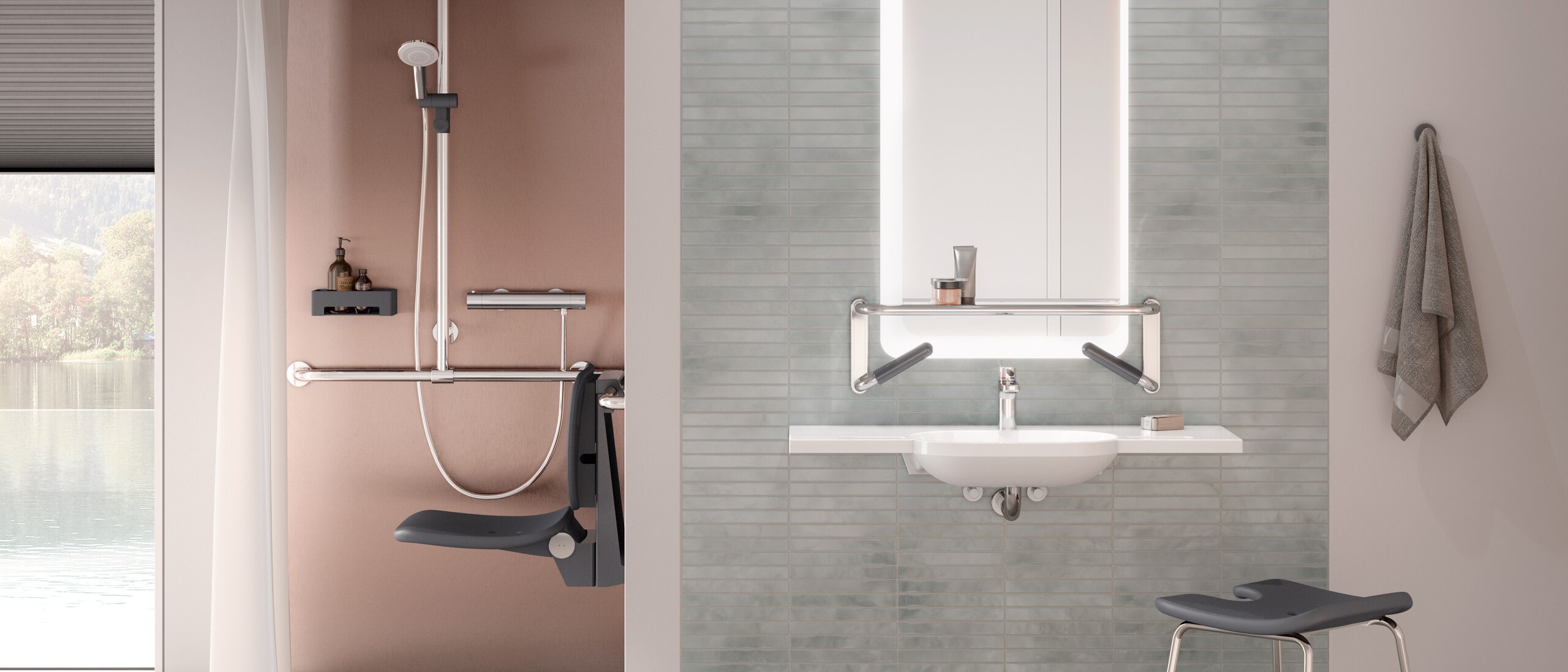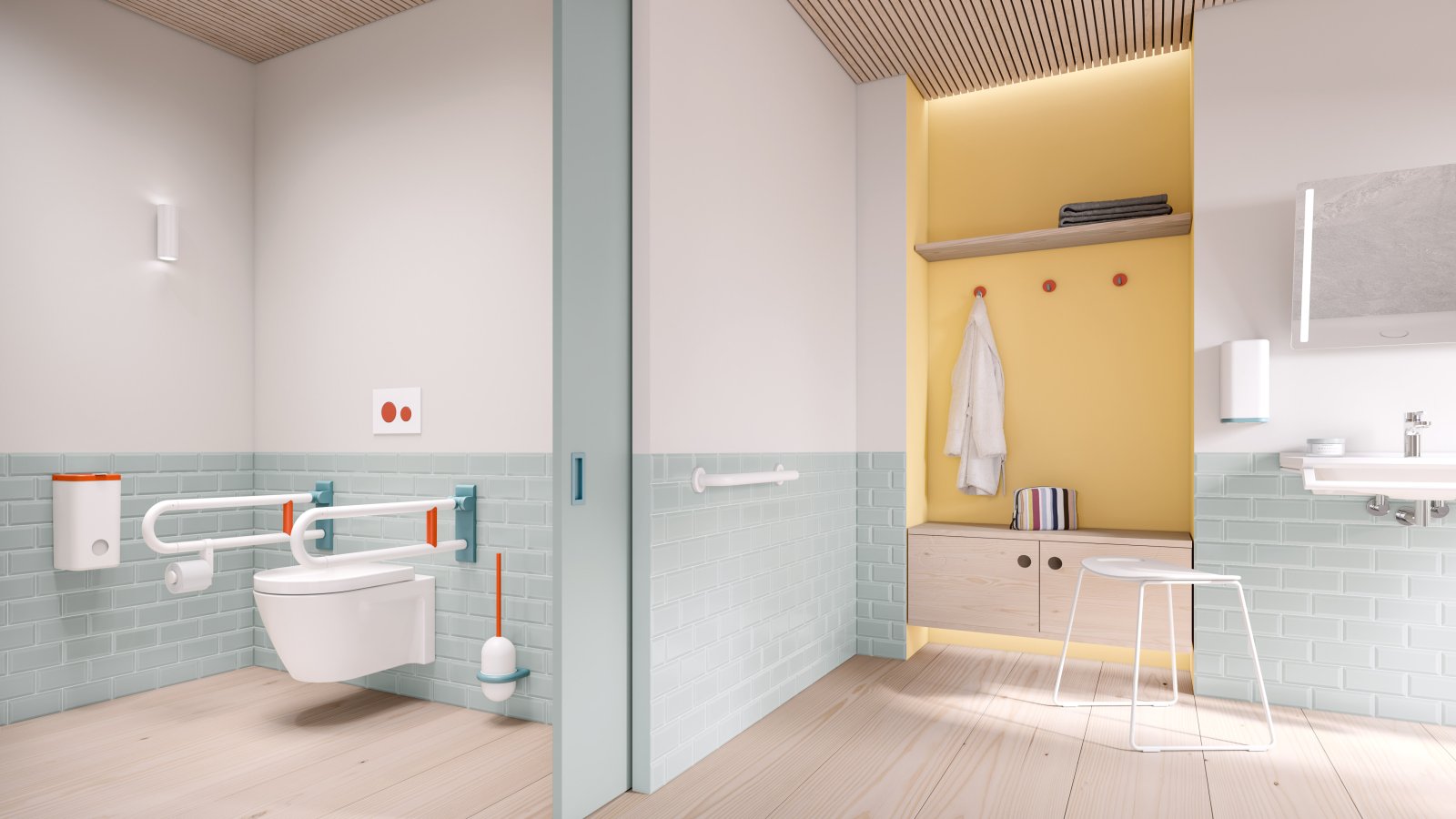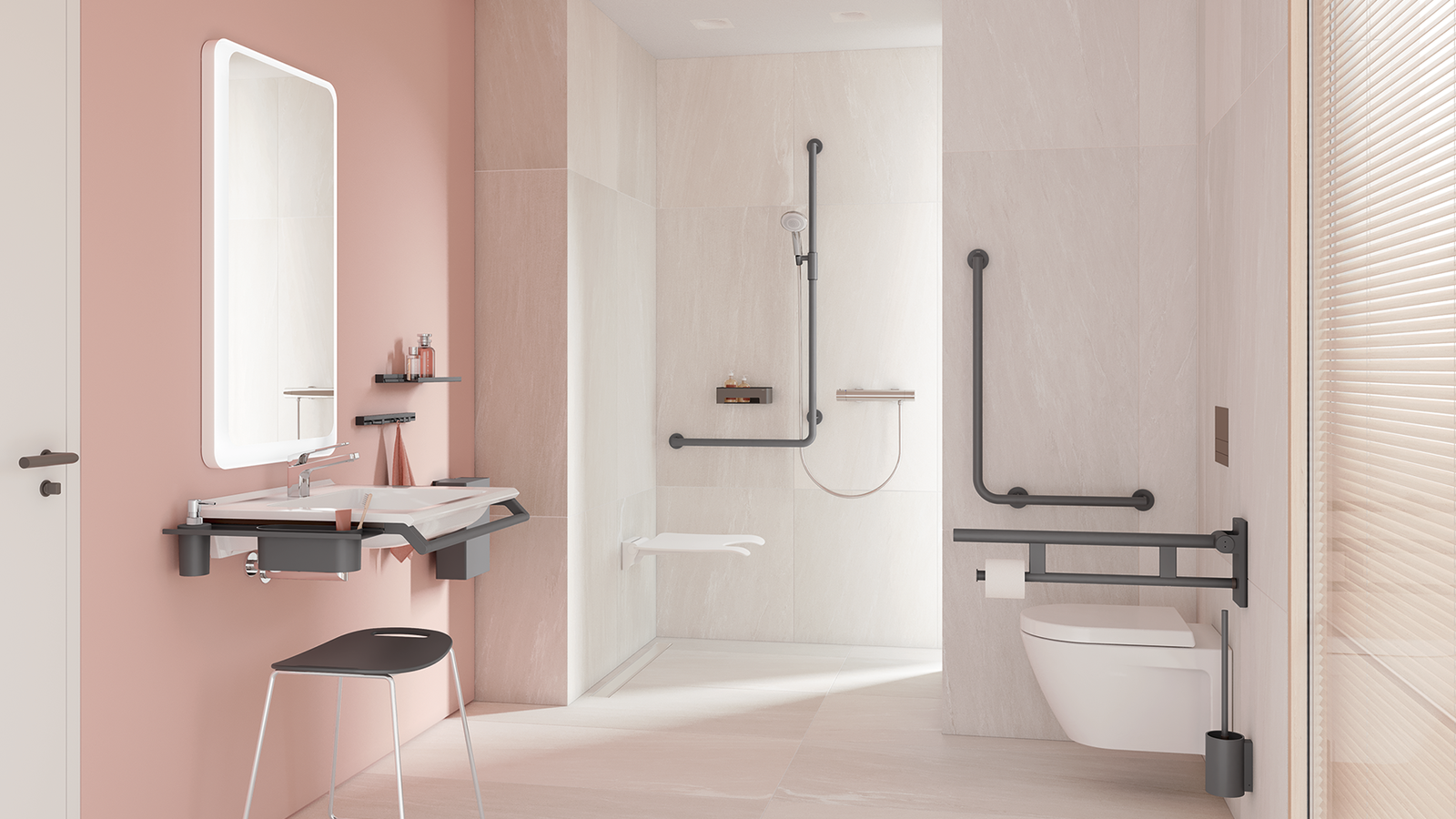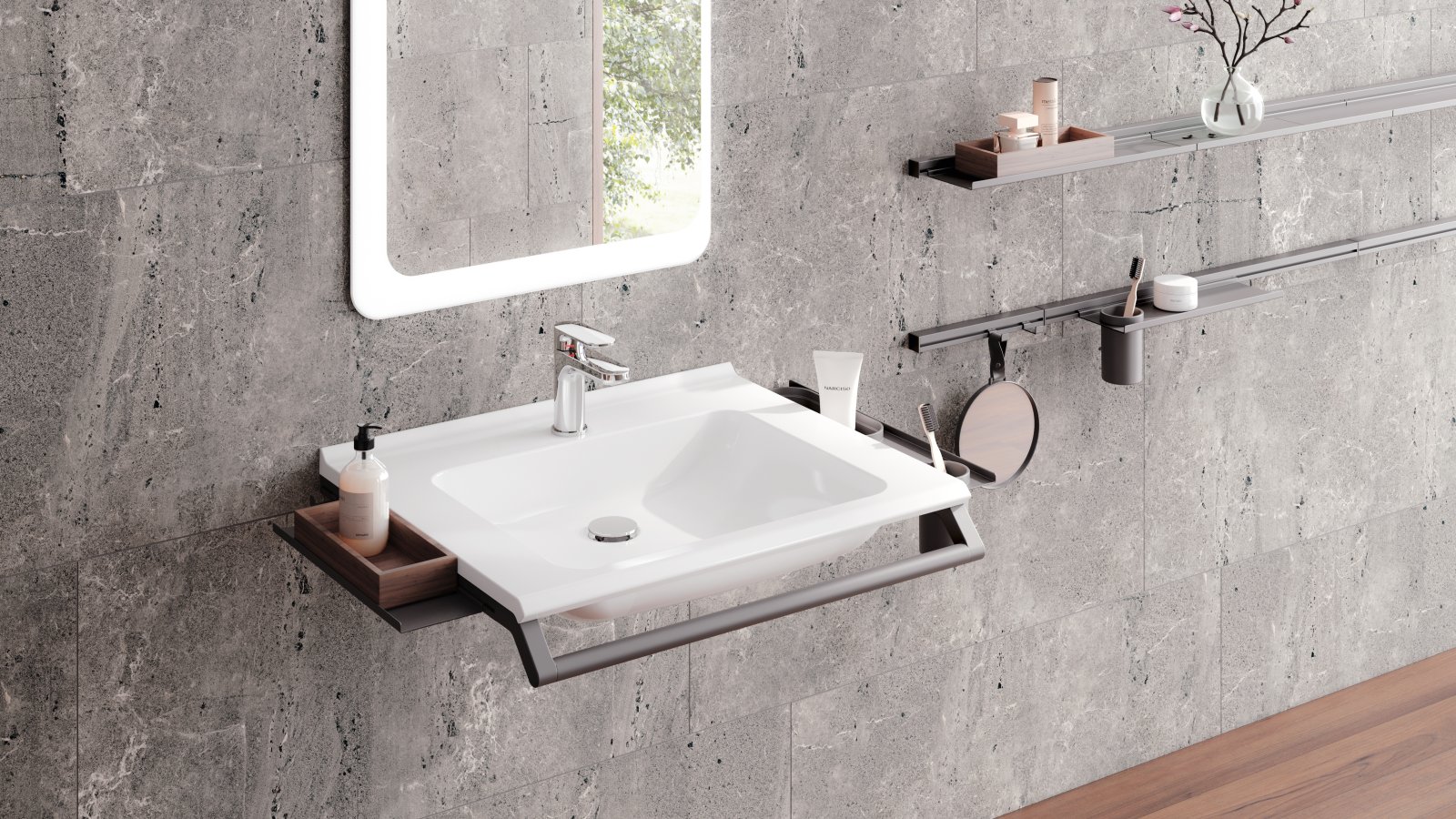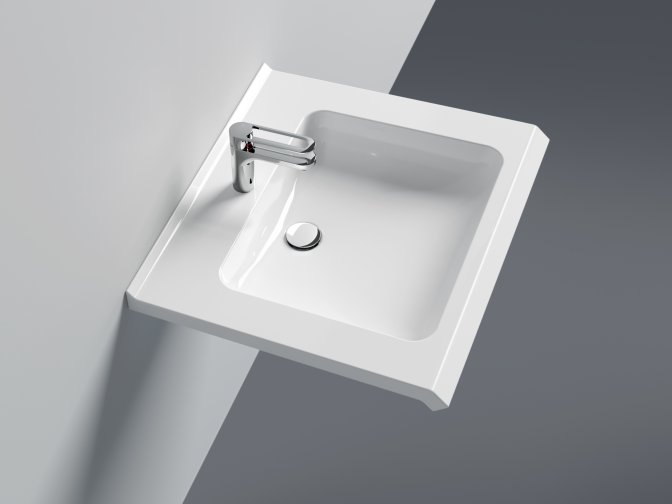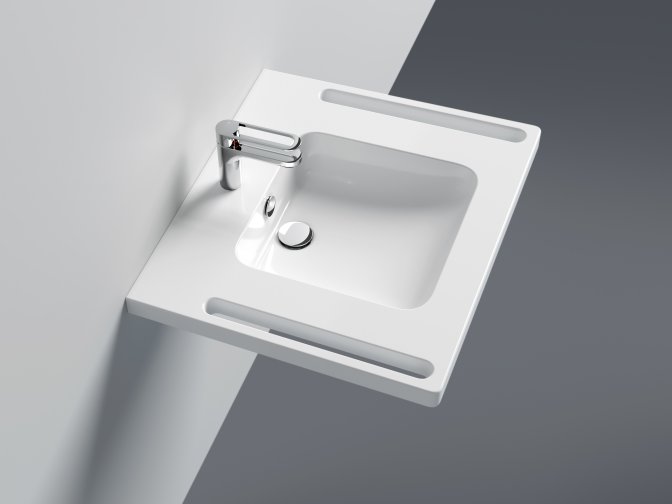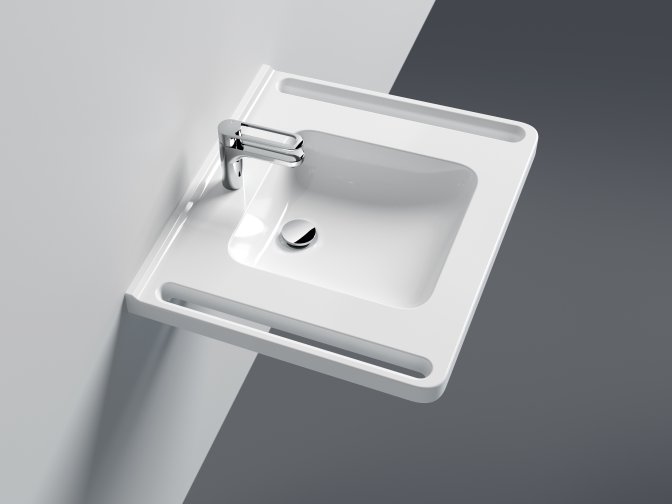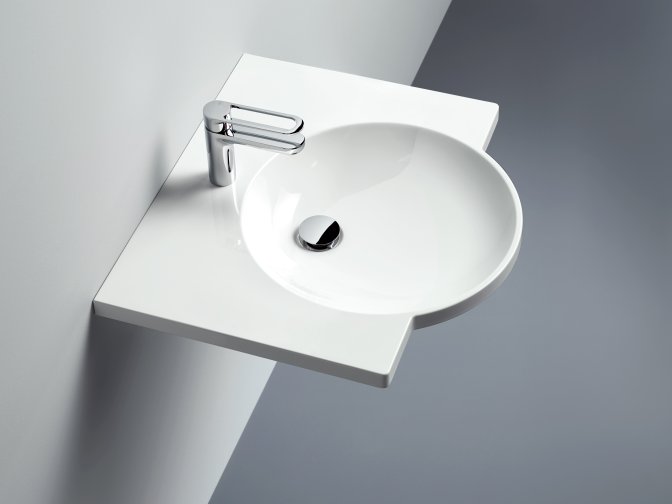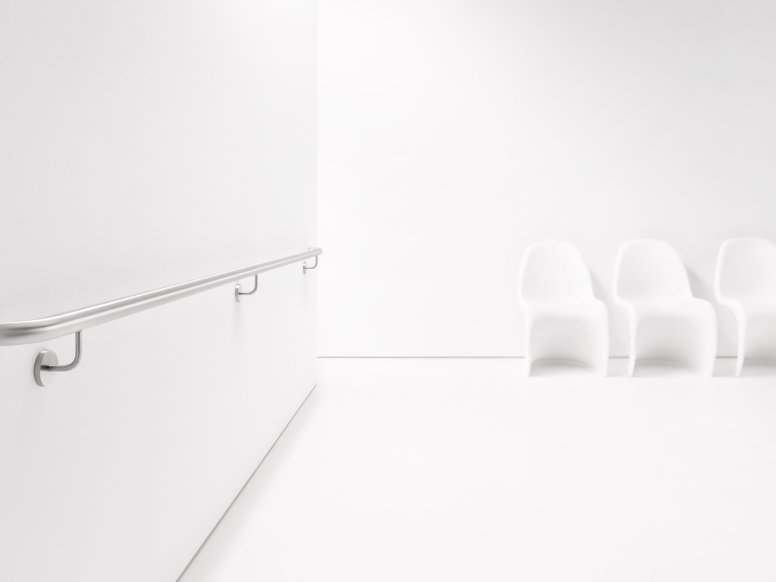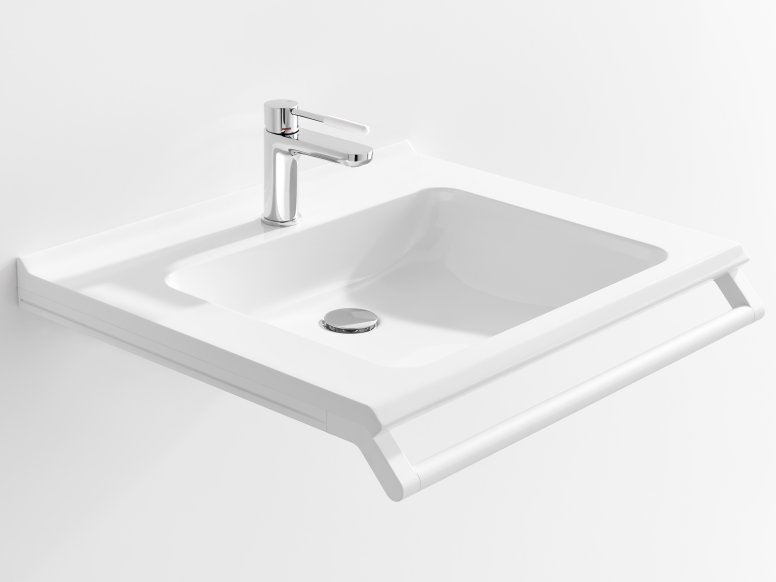HEWI MAG / Sanitary
Accessible bathroom: Tips for planning and design
Building and renovating without barriers is a challenge for many architects, planners and installers. Yet it is hard to imagine housing construction without providing accessibility - and in some cases it is even compulsory in new buildings. More and more people want to (re)build or renovate their flat or house in a way that is suitable for the elderly. So, what do you need to consider when planning an accessible bathroom? This article provides answers and gives advice on what to consider when building or renovating an accessible bathroom.
Accessible bathrooms are not only suitable for people with disabilities or older people. Accessibility is meant for everyone in a household - young, old, healthy, sick.
This is what you can expect in this article:
- Accessibility - what does it actually mean?
- What should an accessible bathroom look like?
- What standards and specifications are there for accessible bathrooms?
- The different areas in the accessible bathroom
- Are there subsidies for accessible bathrooms?
Accessibility - what does that actually mean?
In short, accessibility means that every person has comprehensive access and unrestricted opportunities to use all the areas designed for living. On 1 May 2002, the Act on the Equality of Persons with Disabilities (BGG) came into force. The definition of accessibility can be found in § 4 BGG:
"Structural and other facilities are accessible [...] if they can be found, accessed and used by people with disabilities in the generally usual way, without particular difficulty and generally without outside assistance. The use of disability-related aids is permissible in this context."
However, accessibility supports everyone, not just people with impairments. Around 9.6 million people in Germany live with physical or mental disabilities - of which only four percent are congenital. So instead of hoping for a high life expectancy and no illnesses, the lives of everyone should be designed without barriers. This is especially true for the bathroom. This attitude is in line with the Universal Design Principle, which HEWI has been following for more than 90 years. People and their individual needs are always the focus of product development.
What should an accessible bathroom look like?
The accessible bathroom should first and foremost offer as much movement space as possible between individual sanitary objects. That not only applies to the conversion of a bathroom to suit the needs of the elderly, but to all bathrooms Experience has shown that bathrooms are often designed too small and inadequately equipped. This makes it difficult or impossible for people with disabilities to use public areas, such as accessible sanitary facilities. The primary goal should always be that users can use the bathroom as independently as possible. Holding and support handles can be helpful here, for example, allowing users to sit up and sit down without pain. Doors with flush thresholds that can ideally be opened outwards are also beneficial. An appropriate colour and lighting concept must also be taken into account for accessible bathrooms. Contrasts ensure that people with visual impairments can perceive differences better. This also benefits safety in the bathroom, as it reduces the risk of falls or bumping into things to a minimum.
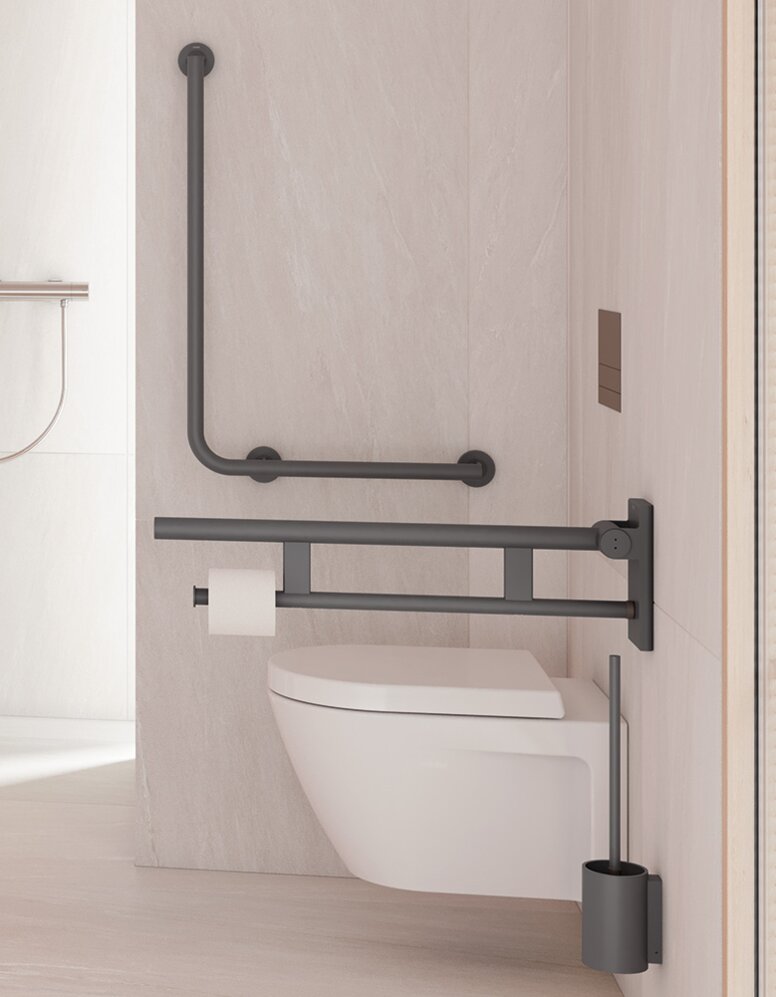
What standards or specifications are there for accessible bathrooms?
Specifications or standards can be found in DIN 18040, more precisely in DIN 18040-2, which clearly presents planning recommendations for the construction and furnishing of dwellings for people with disabilities. For planners and architects, the specifications of the German Institute for Standardisation (DIN) are an important point of reference. As a rule, the bathroom should be designed in such a way that it can be flexibly adapted to the changing needs of the users. You can also find more tips in our free planning guide. The DIN 18040 specifications are presented there in great detail.
The different elements of an accessible bathroom
a. The accessible shower
The free in barrier-free should stand for "freedom" - and for the bathroom in particular, this means that any tripping hazards should be avoided.. For the shower, the widest possible entrance is recommended, which must be flush with the floor. A minimum of 80 cm is recommended - the minimum level specified by the law. Equally important is the choice of the right door. For example, there are swing-folding doors or sliding doors. The former allows the doors to be folded completely against the wall. The latter are true space savers, as no space is taken up in the room for opening and closing the doors. Walk-in showers eliminate the need for doors altogether. Brick walls or free-standing glass surfaces are used, which also serve as splash guards. It is often not possible to achieve the ideal solution, especially in existing bathrooms. HEWI shower curtains are ideal for this purpose, as they are made to measure and are therefore suitable for every structural situation. The shower curtains are ideal for accessible bathrooms and come in many standard sizes. Made-to-measure production is possible on request, even from just a single piece. The same applies to the curtain rails from HEWI.
With regard to the space available, there are clear specifications in DIN 18040-1 and DIN 18040-2 (R). Both in public sanitary rooms and in private flats, a movement area of at least 150 x 150 cm is required for wheelchair use. A floor plan of 120 x 120 cm is required in accessible flats (DIN 18040-2). The shower must not slope more than 2 cm towards the rest of the floor. It is equally important to choose a non-slip floor covering that has at least rating group B according to GUV-I 8527.
With regard to the shower, it is also important to choose the right shower rail. HEWI offers the shower rails WARM TOUCH. It combines the optical properties of high-gloss chrome surfaces with the haptic properties of polyamide. This means that WARM TOUCH products are very warm to the touch, making them perfect for accessible bathrooms and showers. WARM TOUCH is particularly pleasant for patients who are sensitive to cold or who suffer from rheumatism.
One practical feature in an accessible bathroom is when the shower rail can also be used as a grab rail and support handle - which in turn improves bathroom safety. The shower support rail from HEWI can be conveniently extended with HEWI shower handrails, so that users benefit from additional support options and thus even greater safety. System 900 makes it possible to connect handrails and grab rails with each other thanks to its plug and snap-in connection. This means that the former four fastening points can be connected with only three rosettes- which is advantageous for cleaning.
You can find further planning tips for accessible showers:
b. Accessible toilets
If you are planning a barrier-free WC, you will find information in DIN standard 18040-2 about the minimum requirements. In order for wheelchair users, for example, to be able to use accessible WCs, the following should be considered:
- Depth and height of the toilet bowl: The toilet bowl should have a depth of 70 cm to ensure comfortable sitting. This makes it possible to approach the toilet seat from the side. Seating surfaces should be as level as possible so that wheelchair users can easily move from wheelchair to the toilet and vice versa.
- Back support: Wheelchair users find a back support particularly comfortable. This not only provides relief, but also safety in the bathroom.
- Folding support rail: A folding support rail - installed next to the accessible WC - gives users significantly more independence and is therefore recommended. It also provides more stability. Supporting folding handles that are ergonomically designed and have a flat grip surface that provides a secure hold are particularly comfortable. HEWI folding support handles are easy to grip due to their dimensions. The Duo folding support rail, for example, has a second handle surface which makes it even easier to turn sideways towards the accessible toilet or back onto the wheelchair. Users can therefore easily support themselves and pull themselves up. In addition, the HEWI folding support handles can be supplemented with further elements, such as an upgrade kit for a toilet roll holder or a flush release.

HEWI's S 50 modules, which are individually height-adjustable, offer extra comfort. Both the washbasin and the toilet can be conveniently adjusted to the desired height. The radio remote control enables stepless adjustment.
c. The accessible washbasin
When planning an accessible washbasin , there are a number of things to consider. For complete accessibility, it is necessary
- that wheelchair users can also use the washbasin. To do this, it must be able to be lowered by at least 55 cm. This way, the wheelchair user can comfortably use the accessible washbasin . The tap, soap dispenser and towel can also be reached from a sitting position.
- Fitting a mirror that reaches the top of the washbasin allows people sitting to see themselves. A full-length mirror works for everyone - standing, sitting, short or tall.
- use lighting that does not dazzle.
- Make sure that shelves, sockets and fittings are within easy reach of users.
d. What types of washbasins are there?
Different washbasin solutions are conceivable for an accessible bathroom. In addition to models with integrated holding options, there are also those that have a surge edge. These are considered particularly hygienic. Different lengths are also conceivable, which offer various design options.
HEWI washbasins are made of mineral cast and have a non-porous surface. Depending on the version, they feature a surge edge towards the wall, shelves, a deep, rectangular or round basin, all with large radii. Some of the washbasins have practical holding options, which users can use to hold on to or pull themselves up. However, these handles can also be used as towel rails. Other washbasin models have a concealed handle edge. HEWI washbasins can withstand loads in accordance with DIN EN 14688 and are accessible from underneath in accordance with DIN 18040 and ÖNORM B1600/1601.
e. Accessible fittings
An accessible washbasin should ideally be equipped with accessible fittings. Users must be able to operate them easily and, above all, safely in accessible bathrooms. Single-lever mixer taps that are not too small are well suited for this purpose. Ergonomic handles are particularly popular. A longer lever arm also supports gripping and enables the user to operate it with their forearm. If the temperature of the water can also be limited, this helps to protect not only small children, but also older people. Otherwise there is a risk of burns.
HEWI system fittings stand for quality and offer a high level of operating convenience
The HEWI system fittings not only impress with their quality, but also with a high standard of safety. High ease of use, easy cleaning and hygienic design, safe use and ease of maintenance are further attributes. The fact that the fittings are DVGW certified and meet the criteria of DIN 15091 underlines our high quality standards. The HEWI SENSORIC fittings prove to be particularly convenient in accessible bathrooms. They can be triggered with just one hand movement. In addition, HEWI fittings save resources, which can be recognised from the WELL efficiency label. The fittings in the stylish matt black colour are particularly popular at the moment.. They look particularly elegant and set the tone in the room.
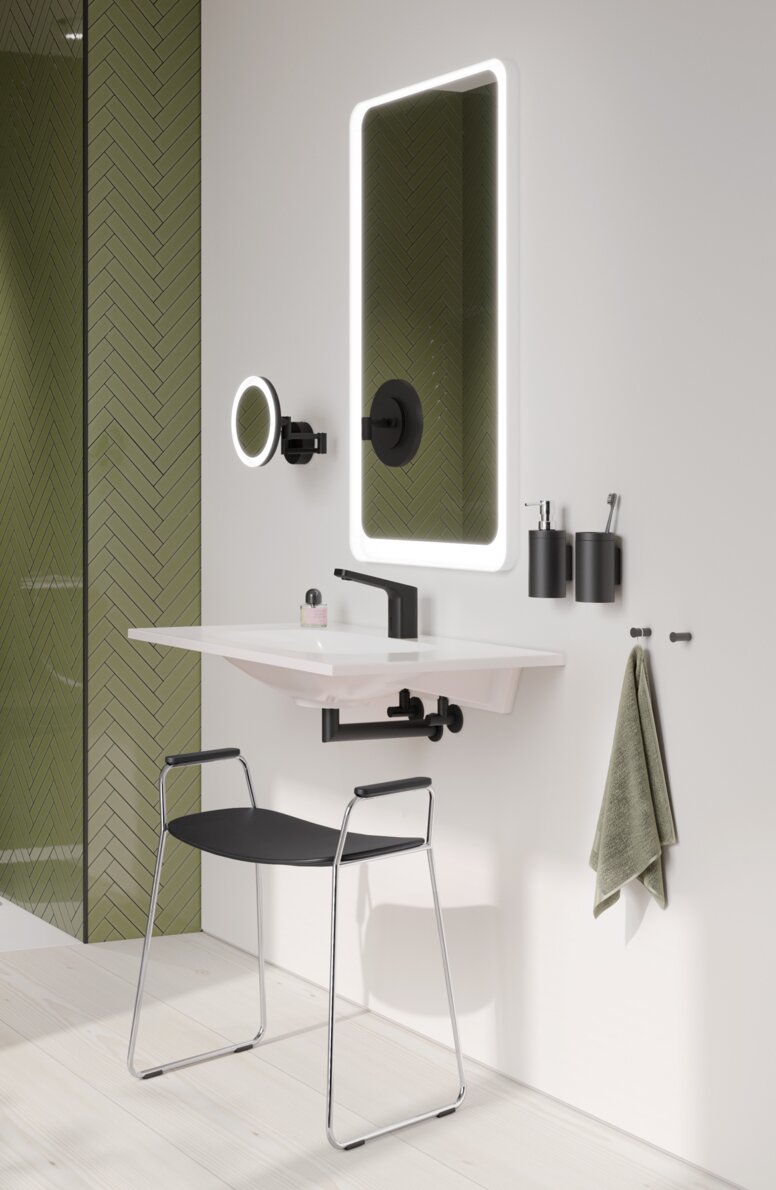

Are there subsidies for accessible bathrooms?
Nowadays, accessible bathrooms represent spacious and comfortable bathrooms. And tomorrow it will be a bathroom suitable for senior citizens. No conversion measures are necessary for this. Planners and architects should tell their clients about the attractive funding opportunities . KfW Bank, for example, offers attractive programmes to renovate bathrooms in an age-appropriate manner. However, the funds are always used up quite quickly. This shows how important this topic is and how many people are concerned about it. Would you like to know when funding under KfW Programme 455-B will be possible again? We will inform you immediately with our newsletter .
In addition to KfW bathroom renovation, however, there are also other options, for example via the long-term care insurance fund. This supports those in need of care in care levels 1 to 5 when it comes to improving the living environment in the flat or house. The funding covers a wide range of conversion measures. For example, in the bathroom, this includes height-adjustable washbasins, accessible toilets and easy-to-operate fittings. Grants are awarded in an amount of up to 4,000 per person and per measure. If several claimants live together, they can be requested up to four times. It should be noted, however, that the subsidy from the long-term care insurance fund and the KfW subsidy cannot be combined. Another option is health insurance funds that reimburse the costs of aids prescribed by a doctor. The maximum funding amount depends on the individual case.
